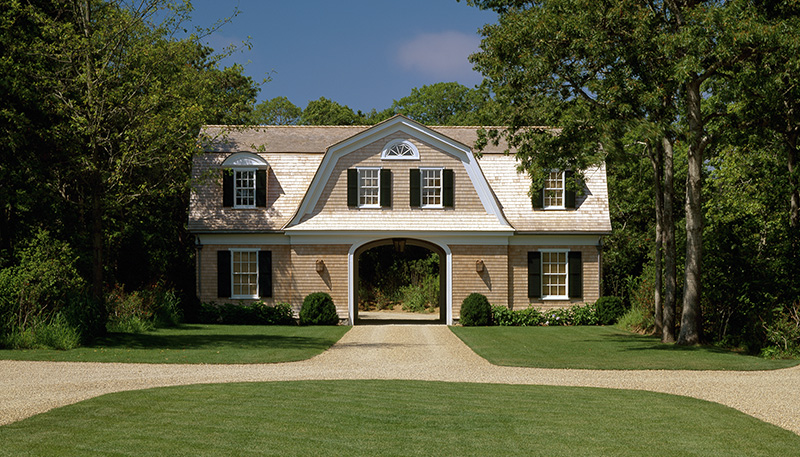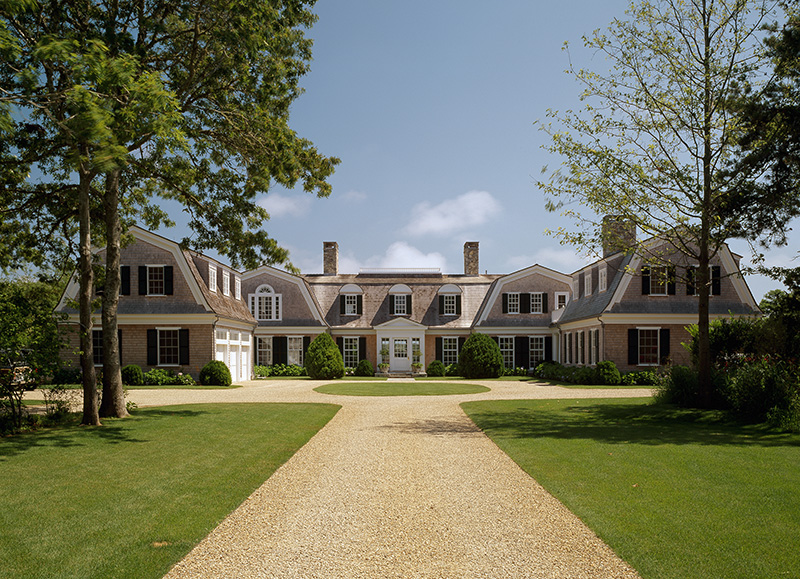Set on a leafy knoll overlooking Edgartown Harbor on Martha’s Vineyard, Witchwood is a jewel box. Not a small holder of trinkets, but an expansive and artful home where sparkling ornamental touches are used as judiciously as a single diamond adorning a vintage hair clip. Sunlight glints off a trio of copper-topped dormers on the home’s front side, framed by a pair of handsome stone chimneys. Perfectly arched openings encourage a sense of expansive freedom. Black iron lanterns, glowing in the soft light of dusk, greet guests as they navigate the front drive, beckoned by a porte-cochere, to arrive at the stately gambrel.
For its designer, architect Patrick Ahearn, AIA, Witchwood is the embodiment of the grand Long Island summer estates that bustled with beautiful people, classic roadsters, and lively cocktail parties of the 1920s that inspired “The Great Gatsby.” “The notion and philosophy of Witchwood is to bring back some of the style of the Gatsby era,” says Ahearn, who works out of offices in Boston, Mass., and Edgartown on the Vineyard. “It was an exciting time in America.”
The Gatsby storyline – about an early-1900s social set of wealthy people whose lives revolved around glamorous parties, tennis, polo, and making connections – resonates deeply with Ahearn. This is a powerful sentiment, coming from a man who loves the full range of American history and has built his practice around designing classical architecture that embraces the Northeast’s historic settings.
The view from Witchwood captures one of the brightest scenes of Americana – a classic harbor playing host to a panoply of watercraft, with wooden workboats scooting around luxurious yachts at anchor. Vineyard Sound washes into the harbor, as the Atlantic Ocean dips and bobs in ever-changing shades of blue and green. Just off the water, fishermen unload their catches and tend to their boats.
Witchwood was a rare synchronistic partnership between Ahearn and its owners, a couple who travel from Palm Beach, Fla., for summers on the Vineyard. The island’s winding roads and historic village settings are perfect for their summer pastimes – taking leisurely drives in their 1959 Corvette and hosting parties in the first-floor great room and around the pool, with Chappaquiddick Island in the distance.
The couple loved the concept of the home from the start. “When I presented my plans to them, 90 percent of the designs remained as is,” he says. “I tried to listen carefully to their goals and objectives.”
  |
In New England’s culturally rich and centuries-old villages and towns, Ahearn is committed to accuracy in scale, volume and proportion. Whether he is renovating a historic home or designing from scratch, he stays true to each location’s historic nature, carefully emphasizing its best views and vistas. “It’s always in the context of each locale,” he says. Ahearn has won many accolades, including two Bulfinch Awards, given annually by the New England Chapter of the Institute of Classical Architecture & Art. The coveted commendation is named for Charles Bulfinch, the country’s first native-born architect and the designer of the iconic Massachusetts State House. Among Ahearn’s other awards are a 2013 induction into the New England Design Hall of Fame and a Chatham Preservation Award, also in 2013.
All grand honors, to be sure, but the most meaningful recognition came last year, when he accepted the Dean’s Outstanding Alumni Award from Syracuse University’s School of Architecture. “I was a student there 42 years ago,” Ahearn says. “This was big for me.”
While American architecture style in the Northeast can make big, bold statements, Ahearn’s inspiration pushes him toward designs with a spirit of ease and comfort that bypasses convention. While Witchwood measures almost 14,000 square feet, Ahearn managed to create an interior that is more intimate than the structure’s size suggests.
With his careful use of volume and technique – such as placing a second-story bridge overlook in view from the one-and-a-half-story entryway – Ahearn created an interior, he says, that “has the ambience of a summer country estate, not a ‘McMansion.’ The reason it feels more house-like and not overdone is scale. It’s 26 feet tall, not 30 feet. The perception that the human eye adjusts to is the proportion and scale of the house.”
Repeated architectural details, such as the softly curved arches, and a thoughtful approach toward the home through the carriage house, set a sublime mood. The connection is deepened with a beautiful courtyard between the two structures.
Inside, Witchwood is devoted to the comfort and warmth of a well-loved home – a large brick fireplace anchoring the formal living room; two rooms devoted to the couple’s favorite art; and a summer living room furnished in casual wicker.
Throughout Witchwood, Ahearn consciously captured views of the setting. Gazing through the home’s main entrance renders a view of the grassy knoll that descends steeply to the ocean edge. A glimpse through the open porch offers a view of the pool and Edgartown Harbor beyond.
A widow’s walk inset into the roof, crowning Witchwood, offers a 360-degree vista of the spectacular setting. Nature, human desire, and creative architecture meet in one grand but comfortable ocean home. “It’s an estate that reflects the environment in a very nice, subtle way,” Ahearn says. “It’s about the sun, water and blue sky.”
For the owners, Witchwood inspires feelings of opening up – to familial relationships, the area’s natural beauty, and life itself. And often, for the couple and Ahearn himself, there are connections to history here, with more than a passing glimpse of a very special time in America’s past.
“If I could go back in history, I’d go to the 1920s,”Ahearn muses. “Cruising Long Island’s north shore in a Duesenberg, hearing the sound of car tires on a gravel drive, taking in a grand estate, and walking into a cocktail party. I’d enjoy that.”
For more information on Patrick Ahearn and Witchwood, visit patrickahearn.com.
Image Credits: Photos by Greg Premru.


